Active 1951–present Founded 1951 | Part of NATO | |
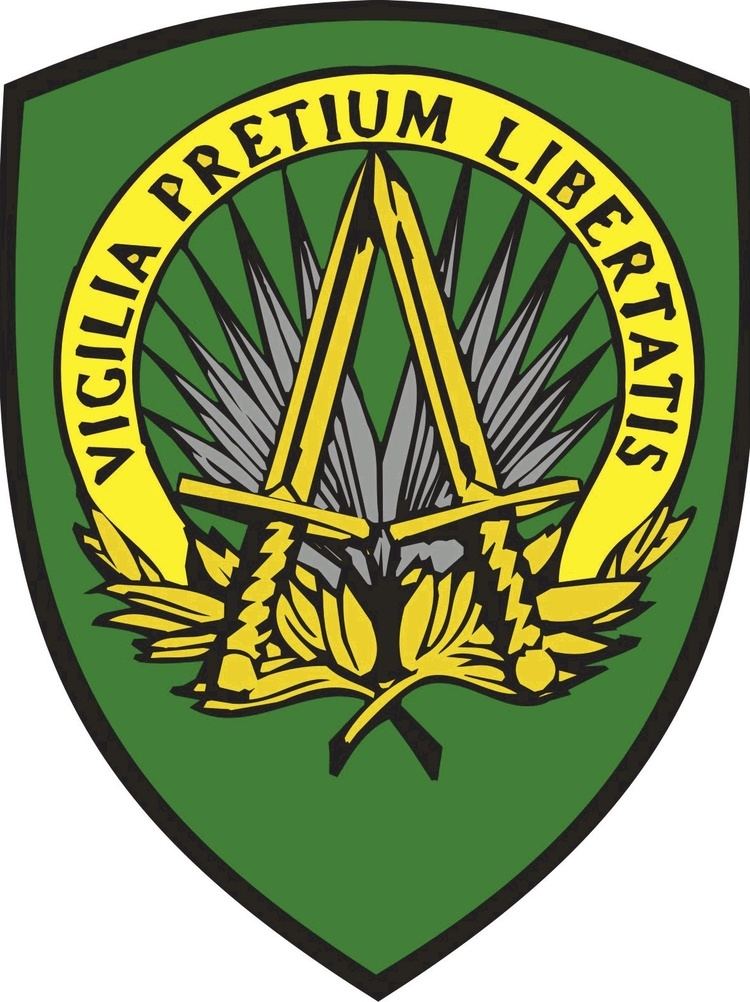 | ||
Motto Vigilia Pretium Libertatis, Latin for "The Price of Freedom is Vigilance". Similar Allied Command Transformation, Allied Joint Force Comman, United States European, NATO Response Force, Allied Joint Force Comman Profiles | ||
Journal interview with manfred lange chief of staff supreme headquarters allied powers europe
Supreme Headquarters Allied Powers Europe (SHAPE) is the headquarters of the North Atlantic Treaty Organization's Allied Command Operations. Since 1967 it has been located at Casteau, north of the Belgian city of Mons, but it had previously been located, from 1953, at Rocquencourt, next to Versailles, France. From 1951 to 2003, SHAPE was the headquarters of Allied Command Europe, ACE. Since 2003 it has been the headquarters of Allied Command Operations (ACO), controlling all NATO operations worldwide.
Contents
- Journal interview with manfred lange chief of staff supreme headquarters allied powers europe
- Top allied military leaders in supreme headquarters allied powers europe and nato hd stock footage
- History
- Initial command structure
- Plans and exercises
- Relocation to Belgium
- The 1970s Haig and Rogers
- Command structure and the 1980s and 1990s
- Structure created in 2003
- Present structure
- Supreme Allied Commander Europe SACEUR
- Deputy Supreme Allied Commander Europe Deputy SACEUR
- In popular culture
- References
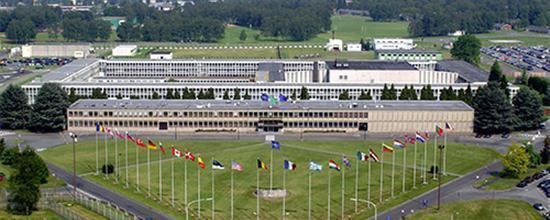
SHAPE retained its traditional name with reference to Europe for legal reasons although the geographical scope of its activities was extended in 2003. At that time, NATO's command in Lisbon, historically part of the Atlantic command, was reassigned to ACO. The commander of Allied Command Operations has also retained the title "Supreme Allied Commander Europe" (SACEUR), and continues to be a U.S. four-star general officer or flag officer who also serves as Commander, U.S. European Command.

Top allied military leaders in supreme headquarters allied powers europe and nato hd stock footage
History
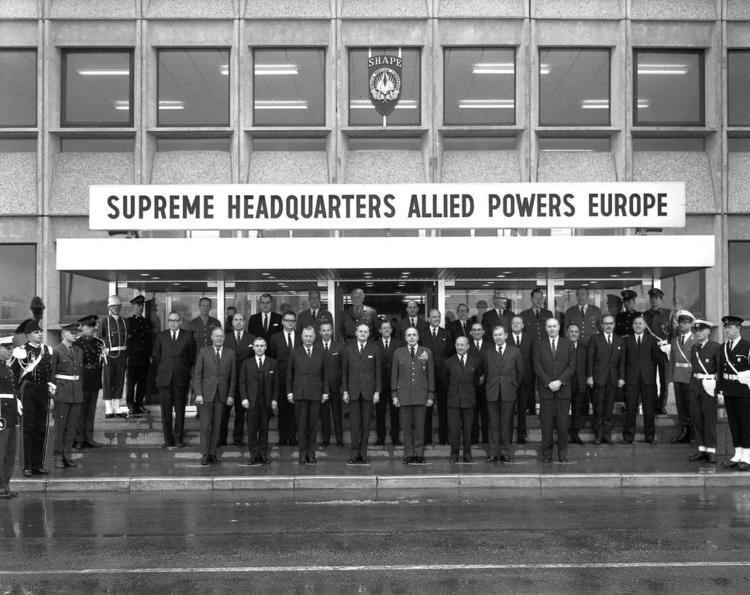
An integrated military structure for NATO was first established after the Korean War raised questions over the strength of Europe's defences against a Soviet attack. The first choice for commander in Europe was American General of the Army Dwight D. Eisenhower, as he had successfully directed the Allied landings in Normandy and subsequent march into Germany during World War II, amid many inter-Allied controversies over the proper conduct of the campaign on the Western Front. On December 19, 1950, the North Atlantic Council announced the appointment of General Eisenhower as the first SACEUR. British Field Marshal Sir Bernard L. Montgomery moved over from the predecessor Western Union Defence Organization (WUDO) to become the first Deputy SACEUR, who would serve until 1958. Volume 3 of Nigel Hamilton's Life of Montgomery of Alamein gives a good account of Montgomery's exacting, tireless approach to improving the command's readiness, which caused a good deal of bruised feelings in doing so. In establishing the command, the first NATO planners drew extensively on WUDO plans and personnel.

General Eisenhower arrived in Paris on January 1, 1951, and quickly set to work with a small group of planners to devise a structure for the new European command. The Planning Group worked in the Hotel Astoria in central Paris while construction of a permanent facility began at Rocquencourt, just west of the city, at Camp Voluceau.
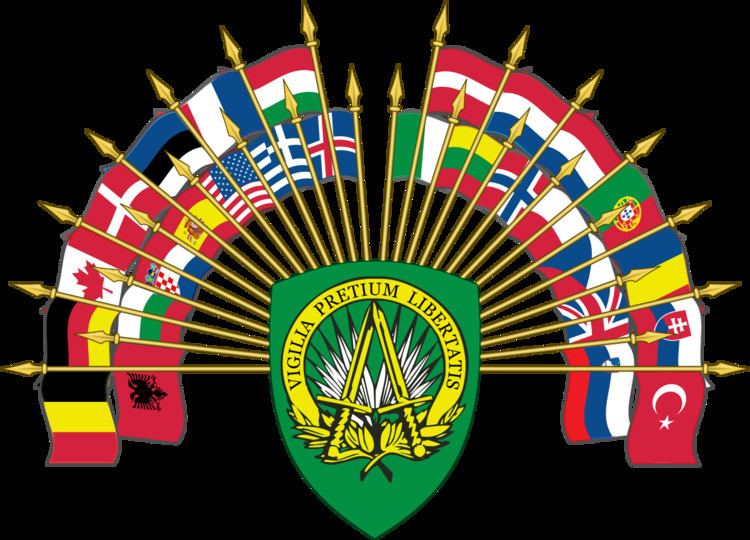
Devising command arrangements in the Central Region, which contained the bulk of NATO’s forces, proved to be much more complicated. General Eisenhower considered naming an overall Commander-in-Chief (C-in-C) there as well but soon realized it would be difficult to find an arrangement that would satisfy all three major powers with forces in the Center—the United States, United Kingdom and France—as they had strongly differing views on the proper relationship of air and ground power. Drawing upon his World War II experience, General Eisenhower decided to retain overall control himself and did not appoint a C-in-C for the Central Region. Instead there would be three separate C-in-C's (air, land, and sea).
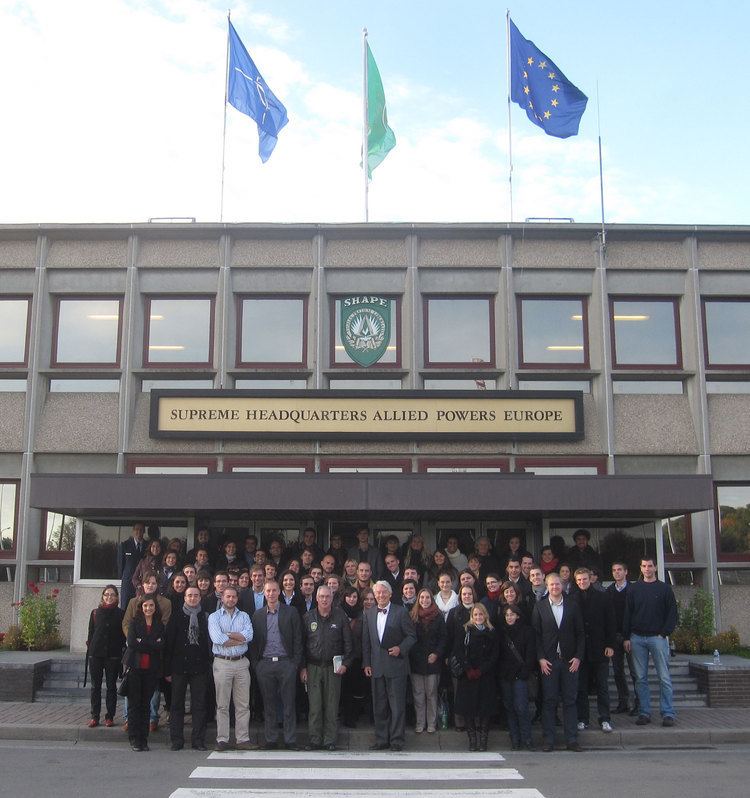
In December 1950 it was announced that the forces initially to come under General Eisenhower's command were to be the U.S. Seventh Army in Germany, the British Army of the Rhine (BAOR), with the 2nd Infantry and 7th Armoured Divisions, to be bolstered by the 11th Armoured Division and a further infantry division, three French divisions in Germany and Austria, the Danish, Belgian, and the Independent Norwegian Brigades in Western Germany, and the American and British garrisons in Austria, Trieste, and Berlin. Four days after Eisenhower's arrival in Paris, on 5 January 1951, the Italian defence minister, Randolfo Pacciardi, announced that three Italian divisions were to be formed as Italy's 'initial contribution to the Atlantic army’, and that these divisions would also come under Eisenhower's control.
Initial command structure
On April 2, 1951, General Eisenhower signed the activation order for Allied Command Europe and its headquarters at SHAPE. Headquarters, Allied Forces Central Europe (AFCENT) was activated in Fontainebleau, France in 1953. On the same day, ACE's subordinate headquarters in Northern and Central Europe were activated, with the Southern Region following in June.
By 1954 ACE's forces consisted of Allied Forces Northern Europe, at Oslo, Allied Forces Central Europe (Fontainebleau), Allied Forces Southern Europe (Paris/Naples) and Allied Forces Mediterranean at Malta.
The commanders and commands in 1957 were:
Plans and exercises
Four exercises were conducted in the ACE area during autumn 1952. Blue Alliance was a major allied air force exercise for the Allied Air Forces Central Europe (AAFCE) to achieve air supremacy over the Central European front and provide close air support to NORTHAG ground forces under the overall command of Lt. General Lauris Norstad, USAF. Two 1952 central region exercises involved air-ground combined forces. Equinox was a major air-ground exercise involving French-American tactical air units and a French airborne infantry unit under the command of Général d'Armée Alphonse Juin, French Army. Holdfast was a major allied air-ground exercise involving 150,000 British Army of the Rhine, Dutch, Belgian and Canadian troops of NATO's Northern Army Group in coordination with the Allied Air Forces Central Europe. They maneuvered east of the Rhine River in the British Zone under the overall command of Lt. General Sir Richard Nelson Gale, British Army. Finally, Rosebud involved ground maneuvers by the U.S. Seventh Army in the American Zone of Occupation of Allied-occupied Germany.
The initial plans saw the defence of Western Europe from a Soviet invasion resting heavily on nuclear weapons ('Massive retaliation'), with conventional forces merely acting as a 'tripwire.' The policy enunciated in Military Committee document MC14/1, issued in December 1952, saw the defence of Germany as principally a delaying action, to allow a line of resistance to be established along the lines of the IJssel and Rhine rivers. The conventional forces would attempt to hold this line while the allied strategic air forces defeated the Soviets and their allies by destroying their economy and infrastructure.
What this strategy meant for the land battle in the central region was described for publicity purposes in January 1954 by then-Supreme Allied Commander Europe General Alfred Gruenther as:
We have... an air-ground shield which, although still not strong enough, would force an enemy to concentrate prior to attack. In doing so, the concentrating force would be extremely vulnerable to losses from atomic weapon attacks... We can now use atomic weapons against an aggressor, delivered not only by long-range aircraft, but also by the use of shorter range planes, and by 280 mm. artillery... This air-ground team constitutes a very effective shield, and it would fight very well in case of attack.
In 1957, SACEUR General Lauris Norstad, USAF, noting the numerical superiority of Soviet and Warsaw Pact forces over NATO ground forces, called for "about 30" divisions to augment NATO’s central European front. That year Allied Command Europe carried out Operation Counter Punch, which involved AFCENT forces on the European mainland, and two other major military exercises in September 1957. Operation Strikeback was a series of multilateral naval exercises that concentrated on NATO's eastern Atlantic/northern European flank. Operation Deep Water involved NATO carrier and amphibious assault forces operating along NATO's southern flank in the Mediterranean Sea.
To improve alliance military readiness and integration, NATO continued to hold annual alliance-wide military exercises each autumn (FALLEX) that was jointly planned and executed by SACEUR and SACLANT forces.
From 1967 however, under 'flexible response', the aim became to build up conventional forces so that, if possible, nuclear weapons might not be needed. However it was made clear that first use of nuclear weapons might be necessary if the conventional defences were being overwhelmed. Eventually SACEUR was allocated planning control of a small number of US and British ballistic missile submarines, and some 7,000 tactical nuclear weapons were deployed in Europe.
Relocation to Belgium
One of the most significant events in the history of Allied Command Europe (ACE) was France's withdrawal from NATO's integrated military structure. This move forced SHAPE and several other ACE headquarters to leave French territory. France's resentment over NATO's military structure had been brewing for a number of years, as successive French governments had become increasingly incensed with Anglo-American domination of the command structure and insufficient French influence. In February 1966 President Charles de Gaulle stated that the changed world order had "stripped NATO of its justification" for military integration, and soon afterward, France stated that it was withdrawing from the NATO military structure. SHAPE and all the other NATO installations, including NATO Headquarters and Allied Forces Central Europe (AFCENT), were informed that they must leave French territory by April 1967.
Belgium became the host nation for both NATO's political headquarters and SHAPE. General Lyman Lemnitzer, SACEUR at the time, had hoped that SHAPE could be located near to NATO Headquarters, as had been the case in Paris, but the Belgian authorities decided that SHAPE should be located at least 50 kilometres from Brussels, NATO's new location, because SHAPE was a major wartime military target. The Belgian government offered Camp Casteau, a 2 km² Belgian Army summer training camp near Mons, which was an area in serious need of additional economic investment. In September 1966, NATO agreed that Belgium should host SHAPE at Casteau. SHAPE closed its facility at Rocquencourt near Paris on 30 March 1967, and the next day held a ceremony to mark the opening of the new headquarters at Casteau.
The drawdown of the British Mediterranean Fleet, the military difficulties of the politically decided command structure, and the withdrawal of the French from the military command structure forced a rearrangement of the command arrangements in the southern region. Allied Forces Mediterranean was disbanded on 5 June 1967, and all forces in the south and the Mediterranean assigned to AFSOUTH in Naples. This left SHAPE and Allied Command Europe with three commands: AFNORTH covering Norway and Denmark, AFCENT most of Germany, and AFSOUTH Italy, Turkey, Greece, and the rest of the southern region.
The 1970s - Haig and Rogers
The headquarters' new home in Mons, Belgium, was the center of international attention from time to time as new Supreme Allied Commanders came and went, with one of the more notable being General Alexander M. Haig, Jr. Haig, who had retired from military service in order to serve as White House Chief of Staff for President Richard Nixon during the depths of the Watergate crisis, was abruptly installed as SACEUR after Watergate's denouement. A creature of habit, Haig took the same route to SHAPE every day – a pattern of behavior that did not go unnoticed by terrorist groups. On June 25, 1979, Haig was the apparent target of an assassination attempt in Mons, Belgium. A land mine blew up under the bridge on which Haig's car was traveling, narrowly missing Haig's car, but wounding three of his bodyguards in a following car. Authorities later attributed responsibility for the attack to the Red Army Faction (RAF). Haig's successor, General Bernard Rogers, became somewhat of an institution in Europe as the former U.S. Army chief of staff occupied the office for nearly eight years; a brief outcry arose from the other NATO capitals when Rogers was slated for retirement by the U.S. administration in 1987.
Command structure and the 1980s and 1990s
ACE in 1986 had three major subordinate commands (MSCs), one each for Northern, Central, and Southern Europe, as well as smaller commands.
From 1993, the staffing of ACE was reduced in line with personnel reductions already in progress since 1990 and the Schaefer Plan, drafted by retired German general Shaefer. Shaefer's aim was to begin the first effort to streamline NATO's Cold War structure to meet the new circumstances. Personnel in the headquarters fell from 18,354 in 1990 to 12,919 in 1996. Costs fell from US $621m to $482m over the same period. From 1994-c.1999, there were three Major Subordinate Commands in ACE: Allied Forces Northwestern Europe at RAF High Wycombe, Allied Forces Central Europe at Brunssum, The Netherlands, and AFSOUTH in Naples.
After much discussion within the Alliance, ACE's three-command system was reduced to two commands covering the same area after 1996, one for north of the Alps and one for south of the Alps. The United States had wished to retain three commands, arguing that 'the span of control might be excessive.' It was feared by Pentagon officials at the time that if the two-command structure was adopted, some functions at the MSC level would have had to be moved 'downward' in the new structure. But while the United States eventually had to give in on a reduction to two commands, it was successful in that a European officer was not placed in charge of the new southern command (now Allied Joint Force Command Naples), a move which France and Germany supported. Despite French President Jacques Chirac exchanging letters with Bill Clinton personally over the issue in September–October 1997, the United States stood firm and today an American admiral remains in charge of the Naples command. In addition to the two continental commands AFNORTHWEST covered the United Kingdom and Scandinavia.
An early retirement again disrupted the Mons headquarters in 2000 as General Wesley Clark was shunted aside in favor of Air Force general Joseph Ralston. Although the move was publicly characterized as a purely administrative move necessitated by Clark's approaching retirement and the lack of an open four-star slot for the highly respected Ralston [a reality which would have compelled him to either accept a temporary demotion to two-star rank or retire from the service], Clark's relief has been often seen as a slap at the general on the part of a Pentagon leadership that had been very much at odds with him during the Kosovo war the previous spring.
From the early 2000s ACO as it became had more and more activities related to the NATO Response Force. Yet after Estonia, Latvia, and Lithuania joined the alliance, and especially after the 2008 Georgia-Russia war, more attention began to be paid to NATO's core Article 5 defence obligations. The three Baltic states' worries were specifically focused on a potential Russian threat. Thus while some exercises were ostentially run to prepare the NRF, sometimes they also included Article 5 aspects. Among these dual-purpose exercises was 'Steadfast Jazz', part of the NATO Exercise Steadfast series, which was run in November 2013 across a number of NATO countries, including Poland and the Baltic states.
Structure created in 2003
In 2003, a French flag was set up in the SHAPE headquarters in Mons following the return, after almost forty years, of French military officers to the HQ. Fifteen French military officers, including General Jean-Jacques Bart, work there, of a total amount of 1,100 personnel. They are however considered as "inserted," and not as "integrated," as they cannot be ordered to move without previous French approval.
A new structure was developed with three main headquarters under Allied Command Operations:
Between 2003 and 2006, a new category of forces was created, principally to improve the flexibility and reach of land forces. The structure incorporates six "NATO Rapid Deployable Corps headquarters." Formed from October 2003, the NATO Rapidly Deployable Corps are designated High Readiness Forces (HRF), designed to be able to react on short notice. Although these forces can not deploy on five days warning like the NATO Response Force (NRF), they have a longer than 30 days sustainment capability in combat than the NRF.
The Multinational Corps Northeast headquartered in Szczecin, Poland, was seen along with the downgraded Greek corps, as the third echelon deployable force in the NATO rapid deployment capability. The Eurocorps HQ, in Strasbourg, France, is an EU force with a technical agreement linking it to NATO.
Certification of the following High Readiness Forces (Maritime) Headquarters took place in 2004:
Naval Striking and Support Forces NATO (STRIKFORNATO), homeported at Gaeta, Italy, whose lead nation is the US, is commanded by Commander United States Sixth Fleet, and is also part of the NATO Force Structure. STRIKFORNATO is the only command capable of leading an expanded maritime task force. The final formation is Commander French Maritime Forces, initially aboard the French aircraft carrier Charles de Gaulle but now aboard the amphibious ship Mistral. The French naval component is drawn from the Force d'Action Navale, the French Navy's surface fleet.
Island Commander, Iceland, remains in existence as a detachment of HQ ACO, as does Allied Submarine Command, a NATO command based on the United States Navy's ComSubLant. A special operations coordination centre and an intelligence fusion centre have also recently been formed within SHAPE.
As more capable rapid reaction forces were established, earlier 'fire brigades', including the ACE Mobile Force (Land) ('AMF (L)'), were disbanded; AMF(L) was disbanded on 30 October 2002.
In addition to this Allied Command Operations has at its disposal standing forces such as:
Airlift support for SACEUR's travels is provided by the USAF's 309th Airlift Squadron at Chièvres Air Base, Belgium.
Present structure
In 2012 and 2013, NATO underwent a reorganization of the military command, and the land component commands at Heidelberg and Madrid were deactivated, the maritime component command at Naples was closed and the air component command at Izmir also shut down.
Today Allied Command Operations (ACO), is one of the two strategic commands of NATO (the other being Allied Command Transformation (ACT) ). Under this structure, there are two joint force operational headquarters and several single service commands under Allied Command Operations:
Supreme Allied Commander Europe (SACEUR)
Since 2003 the Supreme Allied Commander Europe has also served as the head of Allied Command Europe and the head of Allied Command Operations.
Deputy Supreme Allied Commander Europe (Deputy SACEUR)
The position of deputy head of Allied Command Europe – since 2003 known as deputy head of Allied Command Operations – has been held by the following officers. From January 1978 until June 1993 there were two Deputy SACEURs, one British and one German, but from July 1993 this reverted to a single Deputy SACEUR.
In popular culture
Ian Fleming referenced SHAPE in his short-story 'From a View to a Kill', collected as part of For Your Eyes Only.
In the film Private Benjamin, Goldie Hawn's character negotiates an assignment to SHAPE.
